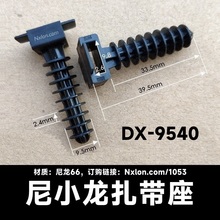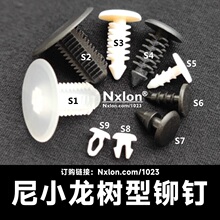Cross Recessed Countersunk Head Screw
©Nxlon.com D/T:

The cross recessed countersunk head screw is a common mechanical connection part. The following is a detailed introduction to the cross recessed countersunk head screw:
Structural Characteristics of the Cross Recessed Countersunk Head Screw
Head: It is in the shape of a countersunk head, that is, the head is conical, and the conical surface forms a certain angle with the axis of the screw, usually 90° or 120°. This shape enables the head of the screw to be flush with the surface of the connected part after installation, making the connection surface flatter and smoother, more aesthetically pleasing, and less likely to produce protrusions, reducing the risk of scratching people and objects.
Cross Recess: Located on the top surface of the head, it is a cross-shaped groove used to cooperate with a cross screwdriver for tightening or loosening operations. The design of the cross recess makes the cooperation between the screwdriver and the screw head closer, enabling the transmission of a larger torque, being less likely to slip, and improving the efficiency of installation and disassembly.
Shank: It has external threads, and the specifications and pitches of the threads are determined according to the size and usage requirements of the screw. The length of the shank also has various specifications to meet the needs of different connection thicknesses.
Specification Dimensions of the Cross Recessed Countersunk Head Screw
Diameter: The common diameter range of the cross recessed countersunk head screw is from M1.6 to M12, such as M2, M2.5, M3, M4, M5, M6, M8, M10, etc. Screws with smaller diameters are usually used for the connection of precision components such as electronic devices and small instruments, while screws with larger diameters are suitable for some mechanical structures that bear greater loads or fields such as furniture manufacturing.
Length: The length specifications are relatively diverse, generally ranging from 6mm to 60mm or even longer, for example, 6mm, 8mm, 10mm, 12mm, 16mm, 20mm, 25mm, 30mm, 40mm, 50mm, 60mm, etc. The specific length selection depends on the thickness of the connected parts and the required fastening depth.
Materials and Surface Treatments of the Cross Recessed Countersunk Head Screw
Materials: It is usually made of medium carbon steel or low carbon steel, such as Q235 steel, 1018 steel, etc. These materials have good processing performance and a certain strength, which can meet the requirements of general mechanical connections. For some occasions that require higher strength and corrosion resistance, stainless steel materials, such as 304 stainless steel, 316 stainless steel, etc., will also be used. The cross recessed countersunk head screws made of stainless steel have excellent rust prevention and corrosion resistance properties and are suitable for harsh environments such as humid conditions and acid-base environments.
Surface Treatments: In order to improve the corrosion resistance, wear resistance, and aesthetic appearance of the screws, surface treatments are usually carried out on them. Common surface treatment methods include galvanizing, nickel plating, chrome plating, blackening, etc. Galvanizing treatment is one of the most common methods. It forms a zinc layer on the surface of the screw, which can effectively prevent rust, has a low cost and good effect, and is widely used in various industrial and civil fields; nickel plating and chrome plating treatments can make the surface of the screw smoother and more beautiful, and at the same time enhance its corrosion resistance and wear resistance, and are often used for some products with high requirements for appearance quality; blackening treatment is to form a black oxide film on the surface of the screw through chemical methods, which has a certain rust prevention ability and a relatively simple appearance, and is often used in some occasions where there are not high requirements for appearance but a certain protective performance is needed.
Application Fields of the Cross Recessed Countersunk Head Screw
Electronic Equipment: It is widely used in the assembly of the casings of electronic devices such as computers, mobile phones, and tablets. Due to its countersunk head design, it can keep the surface of the casing flat, without affecting the overall aesthetic appearance of the device. At the same time, the cross recess is convenient for using a small screwdriver for quick installation and disassembly, which is convenient for maintenance and repair.
Furniture Manufacturing: It is used for the assembly of furniture, such as tables, chairs, cabinets, etc. The countersunk head screws can make the screw heads invisible on the surface of the furniture, making the appearance of the furniture neater and more beautiful, and can provide reliable connection strength to ensure the structural stability of the furniture.
Mechanical Manufacturing: It is also used in the connection of components of some mechanical equipment, especially in occasions with high requirements for the flatness of the connection surface. For example, in the connection of components such as the workbench and fixtures of machine tools, using cross recessed countersunk head screws can ensure the flatness of the connection surface, which is conducive to improving the machining accuracy.
Building Decoration: It is also applied in some indoor decoration projects, such as the installation of doors and windows and the fixing of decorative panels. It can firmly fix components such as the hinges and handles of doors and windows on the door and window frames. At the same time, the countersunk head design makes the surface after installation flatter, more beautiful and generous.
Installation and Usage Precautions of the Cross Recessed Countersunk Head Screw
Select the appropriate screwdriver: Use a cross screwdriver that matches the specification of the cross recess to ensure that the head of the screwdriver can be fully inserted into the cross recess to avoid slipping during the tightening or loosening process, damaging the screw head or affecting the installation effect.
Control the tightening torque: Reasonably control the tightening torque according to the specification of the screw and the material of the connected part. If the torque is too large, it may cause the screw to break or damage the connected part; if the torque is too small, the connection may be loose, and the screw may loosen during use. For some important connection parts, a torque wrench can be used to precisely control the tightening torque.
Pay attention to the installation sequence: In the case of multiple screw connections, the screws should be tightened in a certain order to ensure that the connected parts are evenly stressed and avoid deformation or uneven installation. Generally speaking, it is necessary to start from the center of the connection part and gradually tighten the screws symmetrically towards the periphery.
Inspection and maintenance: During the use process, regularly check the connection condition of the cross recessed countersunk head screws. If problems such as loosening, rusting or damage of the screws are found, tighten, replace or take corresponding rust prevention measures in a timely manner to ensure the reliability and safety of the connection.
尼小龙塑料螺丝-塑料螺母-尼龙垫圈-塑料铆钉
塑料铆钉-尼小龙树形铆钉
订购链接:Nxlon.com/1023
绝缘塑料树形铆钉又称倒齿形塑料铆钉或圣诞树型塑料铆钉品名:树型塑料铆钉;材质:尼龙 Nylon;适合孔径:5.5mm-6.5mm;适合板厚:2.0mm-10.0mm
R2024-塑料铆钉-尼龙铆钉
订购链接:Nxlon.com/2024
R2024-塑料铆钉-尼龙铆钉塑料铆钉-尼龙铆钉-汽车塑胶铆钉-尼小龙尼龙铆钉R2.6R3.5R4R5塑胶柳钉子母铆钉快捷紧固件塑料卡扣。
R2040-塑料铆钉-尼龙铆钉
订购链接:Nxlon.com/2040
R2040-塑料铆钉-尼龙铆钉塑料铆钉-尼龙铆钉-汽车塑胶铆钉-尼小龙尼龙铆钉R2.6R3.5R4R5塑胶柳钉子母铆钉快捷紧固件塑料卡扣。









